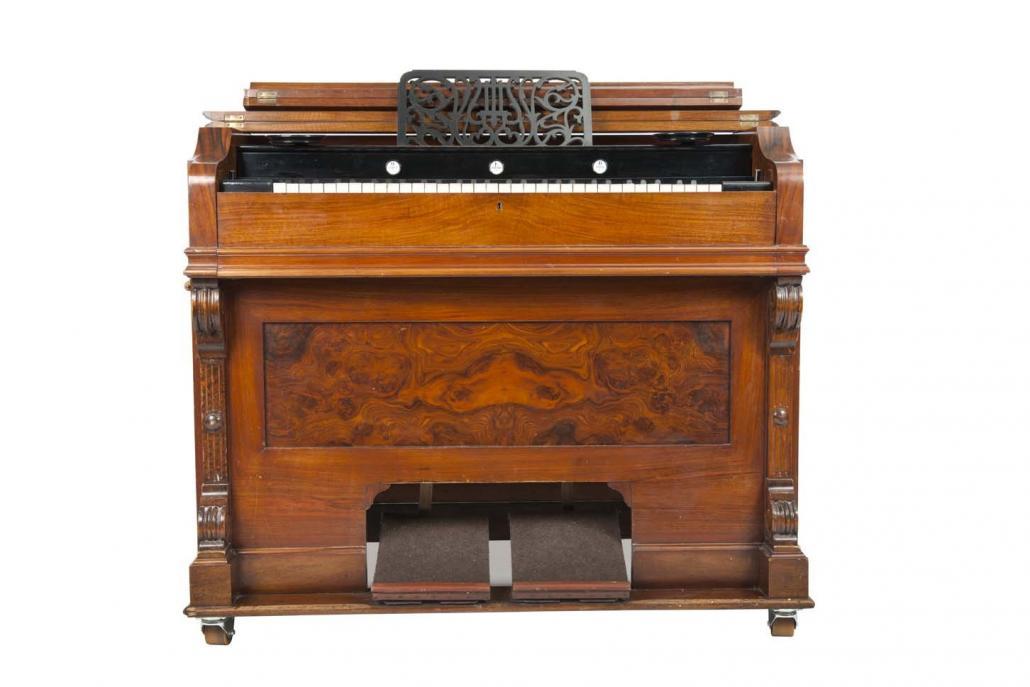

The Italians had for many years exhibited the street piano, a rudimentary instrument on a wheeled cart, worked by a wood cylinder turned by a crank pins in the cylinder slammed hammers loudly against the strings. There were a number of early attempts at mechanical piano players, including a fine one called a “Pianista” invented by a Frenchman named Fourneaux, which was introduced at the Philadelphia Centennial Exhibition in 1876, but it was very expensive. A traveling perforated paper roll of anything from forty-four to sixty-five notes’ compass actuated felt-tipped wooden rods that dropped down on the piano keys and played them. You rolled it up to your piano keyboard, adjusted several knobs for height, then sat in front of it (some distance by now from the piano itself) and pumped two treadles that worked its pneumatic insides. It was called a “piano player,” and it was on wheels. The machine that blew across the country, starting in the late 1890s, like a blizzard over a Nebraska plain was not, in fact, a player piano. The years of hard study and endless practice were replaced in a moment by the marvel of a machine that could play a piano far better than any amateur and, moreover, play it again and again for as long as anyone could stand it. It is small wonder, then, that the advent of the self-playing piano seemed miraculous. Those of us who are not musicians, offered a sight of any mildly elaborate piano score, recoil in shock from a sheaf of coded material so dense that the page seems almost black this must somehow be transferred from the printed score to the keyboard, to be played with both hands. Throughout the nineteenth century, well-bred young women “took.” “Taking” meant piano lessons: learning to arch the fingers properly not to stoop the back, and to master all the crossing of the hands necessary to accomplish such dainty and showy works as Ethelbert Nevin’s “Narcissus,” surely one of the world’s most insipid compositions.īut learning to play was never easy. Piano ownership had connoted gentility for generations before the arrival of the player piano.

A piano that worked, bought for as little as thirty dollars, was heaven, whether you could play it or not. Lost in a limbo brought on by the growing popularity of radio before the Second World War, they were bought by the freight carloads for peanuts, divested of their automatic innards, and shipped to Southern states, where they were resold as ordinary upright pianos to people for whom the ownership of a piano was still an emblem of middle-class dignity but who had never been able to afford one before. Some simply were discarded, but thousands of others suffered an ignominious surgery. Many of the pianos themselves fetch high prices, for so many of the hundreds of thousands made are gone. People still find them a great pleasure, repairing them, rebuilding them, adding more piano rolls to their libraries (the market in secondhand rolls is brisk).
Farrand piano serial numbers how to#
The Vestal Press has long had a successful book in print on how to restore player pianos, and an enterprising firm in Kansas is busy supplying spare parts for them. Rolls for the pianos have been manufactured continuously since the 1890s, and new ones are still being made. But although player pianos have been manufactured only desultorily since, the machine established itself so firmly during its brief lifetime that it is impossible to find someone today who doesn’t know what a player piano is, who doesn’t remember what fun they were.

The craze dwindled, and in 1932 not a single player was shipped from the factories. Within four decades it appeared to be dead. The player piano came of age in America ninety years ago, and it caused an almighty stir.


 0 kommentar(er)
0 kommentar(er)
